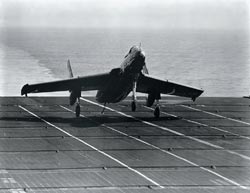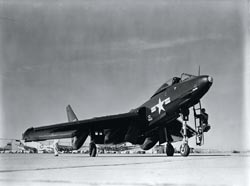|
 Based on initial flights of the XF7U-1 airplane in 1948, the U.S. Navy ordered fourteen of the production versions of the airplane, the F7U-1. Powered by two J34-WE-32 engines with Solar afterburners, the production model incorporated several improvements. The vertical fins were extended to provide more area to eliminate directional “hunting” in high-speed flight. Two wing pylons were added, which permitted the carrying of two 250-gallon external fuel tanks. The main gear extension system was designed to permit a further forward wheel position for takeoff than the position used for landing. The nose gear was designed so the “oleo” could be fully extended for takeoff, providing 3 degrees of increased wing angle-of-attack for takeoff while the main gear aft extended position provided 3 degrees of increased angle-of-attack for landing on the carrier deck Based on initial flights of the XF7U-1 airplane in 1948, the U.S. Navy ordered fourteen of the production versions of the airplane, the F7U-1. Powered by two J34-WE-32 engines with Solar afterburners, the production model incorporated several improvements. The vertical fins were extended to provide more area to eliminate directional “hunting” in high-speed flight. Two wing pylons were added, which permitted the carrying of two 250-gallon external fuel tanks. The main gear extension system was designed to permit a further forward wheel position for takeoff than the position used for landing. The nose gear was designed so the “oleo” could be fully extended for takeoff, providing 3 degrees of increased wing angle-of-attack for takeoff while the main gear aft extended position provided 3 degrees of increased angle-of-attack for landing on the carrier deck
First flight on March 1, 1950 and delivery in June provided the Navy with the airplane for carrier suitability testing. This vigorous testing produced negative results which are as follows:
- Pilot visibility was unsatisfactory in final carrier approach.
- Wave-off characteristics for latter stage wave-offs were unsatisfactory.
- The arresting hook assembly was so complicated that its practicability for service use was doubtful.
 The carrier suitability testing, which was completed in August 1951, essentially doomed further production of the F7U-1 and led to the design of a completely modified F7U, the F7U-3. F7U-1’s were used extensively for flight-testing and were flown briefly by the Navy Blue Angels Demonstration Team. The carrier suitability testing, which was completed in August 1951, essentially doomed further production of the F7U-1 and led to the design of a completely modified F7U, the F7U-3. F7U-1’s were used extensively for flight-testing and were flown briefly by the Navy Blue Angels Demonstration Team.
More F7U:
Production
F7U-3 Engine Story
F7U-3 Production
The last of the Corsair and the Cutlass
|